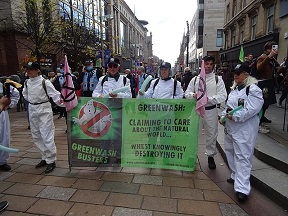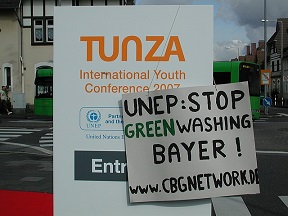The booming demand for sustainable products is associated with increasing consumer consciousness of environmental problems. As a result, the biobased industry is thriving and companies are now opting for biomass-derived alternatives instead of their petrochemical counterpart to formulate products. Unfortunately, some brands falsely promote their products as plant-based to attract green consumers, a practice better known as greenwashing.

In an effort to allow consumers to identify genuine plant-based products in the market, companies can submit ingredient samples to a third-party laboratory for biobased testing using carbon-14 analysis. Biobased products are composed wholly or partially of biomass resources and organic materials that come from plant and animal sources. Through carbon-14 testing, brands can display the use of biobased ingredients, increasing consumer confidence.
Greenwashing: A Challenge for the Green Market
The green market often faces challenges of greenwashing in which brands falsely advertise products as environmentally friendly. For example, product packaging and labels may contain green colors and nature or leaf imagery, creating confusion and preventing consumers from making the right purchase decision.
In an effort to address greenwashing and provide clarity to consumers, companies may submit their products for third-party laboratory testing as part of their quality control and quality assurance procedures in addition to applying for certification programs and eco-labels.

How To Validate Biobased Ingredients Through Carbon-14?
Carbon-14 testing is often used to determine the age of archaeological and geological materials. However, the presence of carbon-14 in plants and animals also makes the analytical method suitable for accurately calculating the biobased carbon content of a given sample.
Radiocarbon, also known as carbon-14, is a radioactive isotope produced in the atmosphere through cosmic rays from the sun. All living organisms assimilate atmospheric CO2 including carbon-14. When organisms die, they stop absorbing carbon and their carbon-14 content starts to decrease gradually. Due to this, carbon-14 acts as an accurate method to determine if a material contains recently living carbon as opposed to petrochemical-derived substances.
The carbon-14 measurements are determined by using accelerator mass spectrometer (AMS) technology which is applicable to liquid, solid, and gaseous samples. Testing results are expressed as a percentage value ranging from 0% biobased content to 100% biobased content. For example, an entirely biobased packaging product will result in 100% biobased content, whereas a packaging product derived from only petroleum sources will yield a result of 0% biobased. A value in between indicates that the product is derived from a mixture of biomass-based and petroleum sources.
Carbon-14 Testing Required By US and European Standards
Analytical standards play a key role in quality assurance since they directly impact biobased results. By implementing internal quality processes, laboratories can prevent errors and provide accurate data. There are numerous testing standards based on carbon-14 analysis that apply to biobased plastics and biobased products in general. For example, ASTM D6866, a standardized method developed by the American Society for Testing and Materials in the US, requires carbon-14 testing to determine the biobased content of liquid, solid, and gaseous samples. The ASTM D6866 standard is widely used to apply for certification under the USDA BioPreferred® Program.
On the other hand, ISO 16620, an internationally recognized standard, establishes the use of radiocarbon analysis for plastic products. It expresses biobased carbon content as a fraction of total carbon content or total organic carbon content.
In Europe, there are three main analytical standards for biobased packaging products. For example, the EN 16640 standard applies to all biobased products and it measures biobased carbon content as a fraction of total carbon content using carbon-14 analysis. Additionally, EN 16785 determines the biobased content of solid, liquid, and gaseous materials containing carbon through carbon-14 testing. Lastly, EN 17228 determines the biobased content of bioplastics and polymers.
Biobased Certification Programs
Product certification serves as a powerful marketing tool for manufacturers and suppliers to position their products in the marketplace. In both the US and Europe, a number of certification schemes require or recommend the use of carbon-14 testing.
The USDA BioPreferred Program has become very popular not only for certifying products but for promoting consumer awareness and the biobased economy. The program consists of 139 product categories. Each one has a minimum percentage of biobased content established. For example, packaging products must have at least 25% of biobased content to obtain a certification. Successful applicants who meet these minimum standards are granted permission to display the USDA Certified Biobased Product label on their product packaging. The biobased content should be determined following the ASTM D6866 method using a third-party testing laboratory.
Additionally, the UL 9798 Bio-based Product Content Validation, which is applicable to plastic products, recommends the use of carbon-14 testing in accordance with ASTM D6866. Applicants that obtain the certification are able to display the UL badges in their products and are listed in the UL green product database.
In Germany, the DIN CERTCO DIN-Geprüft Biobased scheme applies to all products that have a minimum of 20% biobased content. Under this program, there are three levels to measure the percentage of biobased content: 20-50% biobased, 50-85% biobased, and >85% biobased content. The carbon-14 measurements are determined in accordance with ASTM D6866.
Furthermore, the Vinçotte OK Biobased, a certification scheme in Belgium, certifies bioplastics and biobased products tested in accordance with EN 16640. The biobased content is classified using a star scheme. One star indicates the product contains between 20-40% biobased content whereas four stars reveal the product contains more than 80% biobased content.
Conclusion
Biobased certifications and standards combined with carbon-14 testing are key to regulating the biobased product market and addressing greenwashing. Consumers expect biobased products to be genuine, driving companies to validate their biomass-based ingredients. At a corporate level, carbon-14 testing allows companies to apply for product certification supporting their marketing efforts and product positioning. At a consumer level, certified biobased products increase confidence and trust in the brand, at the same time promoting transparency in the biobased market. Therefore, carbon-14 testing poses a solution to mislabeling and greenwashing practices by accurately determining biobased content and validating product claims.
Information supplied by Beta Analytic, www.betalabservices.com
Interesting? Then also read:
Sustainability is crucial for success, says Lux Research
Reconnect with nature – the new sustainability
Coca-Cola blunder: non-information on the plant bottle – latest in a series of incidents
